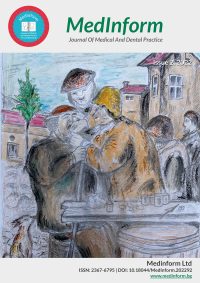Issue Two 2022
2022, Vol. 9, issue 2, (September)
Literature Review
3D printed, and CAD/CAM milled indirect restorations from hybrid polymers. Mechanical properties. A Literature Review
Abstract:
This literature review examines the composite materials for making inlay, onlay, and overlay using Computer-aided design and computer-aided manufacturing (CAM) technologies (Subtractive manufacturing technologies (milling) and Additive manufacturing technologies (3D printing)). The chemical composition and mechanical properties of composite materials for making inlays, onlays, and overlays were described. The types of composite materials with ceramics were considered:1.Composite blocks with dispersed ceramic particles, and 2. Composite blocks with a ceramic network for milling and materials composed of monomers based on acrylic esters or filled hybrid material for 3D printing. From the mechanical properties, the following were compared: flexural strength, flexural modulus, hardness, Vickers hardness, hardness shore, and wear. These are important for determining the durability of future structures for the restoration of hard dental tissues and their wear in the conditions of the oral environment. The composition of the materials for computer-aided constructions determines their mechanical properties. The study of the mechanical properties of the materials has established that milling materials are suitable for permanent structures. In contrast, 3D printing materials are more suitable for temporary crowns, wax-up and mock-up models, and restorations in the oral cavity. Further laboratory and clinical studies are needed to explore the exact limits of their application.
Keywords: CAD/CAM, composite blocks, 3D printing, mechanical properties
Authors:
Georgi Iliev; Department of Prosthetic Dental Medicine, Faculty of Dental Medicine, Medical University of Sofia, Bulgaria ;Radosveta Vasileva; Department of Conservative Dentistry, Faculty of Dental Medicine, Medical University of Sofia, Bulgaria;
Viktoria Petrova; Department of Conservative Dentistry, Faculty of Dental Medicine, Medical University of Sofia, Bulgaria;
Christiyan Bozhkovski; Department of Conservative Dentistry, Faculty of Dental Medicine, Medical University of Sofia, Bulgaria;
Dimitar Kirov; Department of Prosthetic Dental Medicine, Faculty of Dental Medicine, Medical University of Sofia, Bulgaria ;
Janet Kirilova; Department of Conservative Dentistry, Faculty of Dental Medicine, Medical University of Sofia, Bulgaria;

